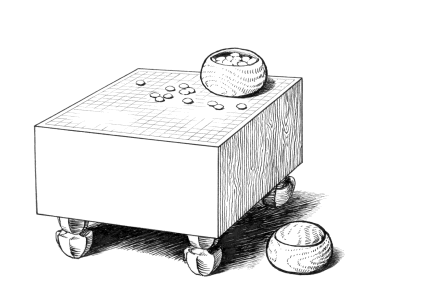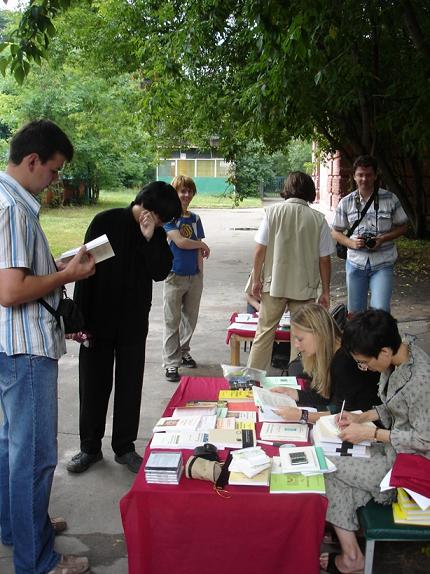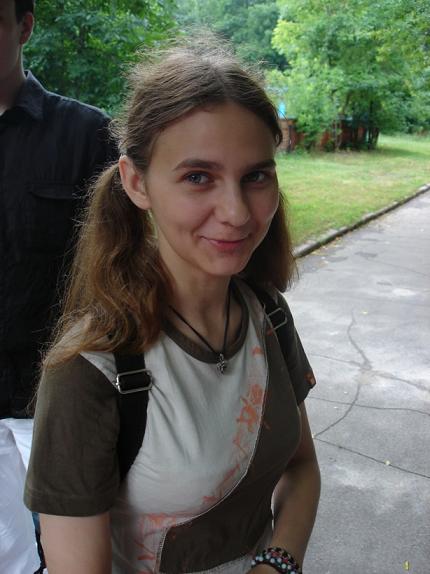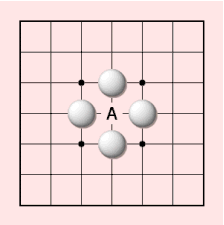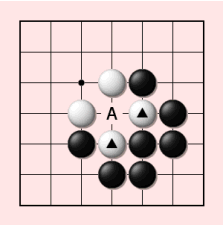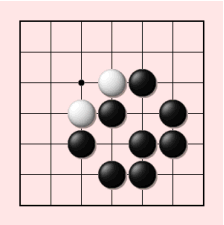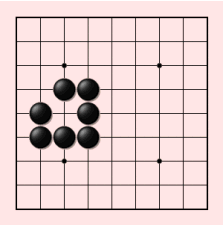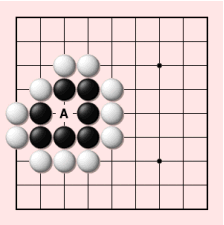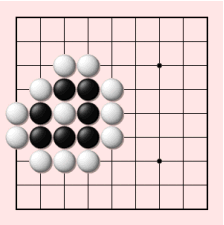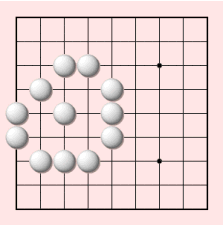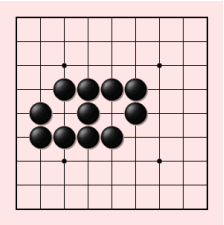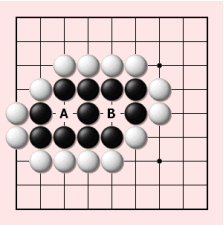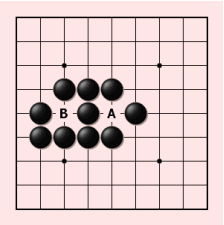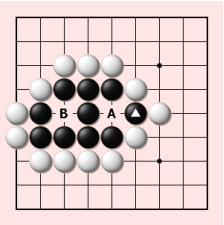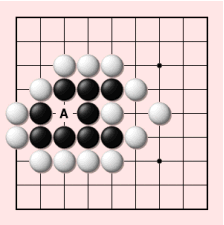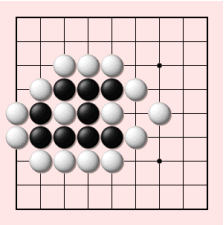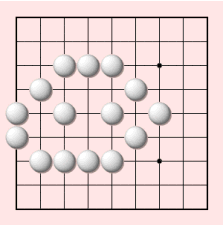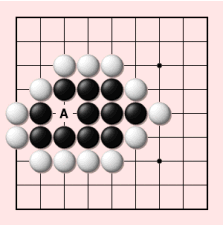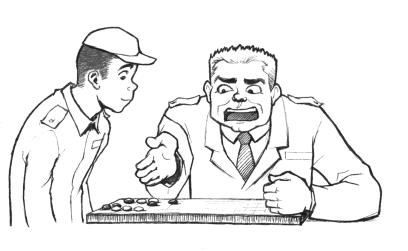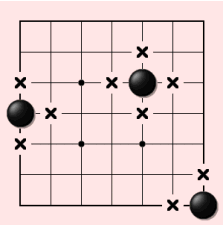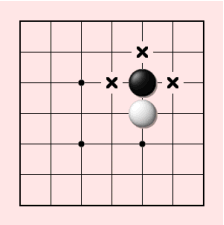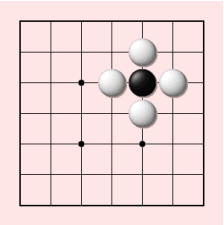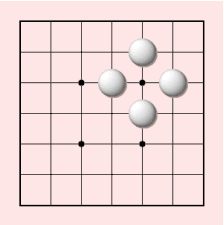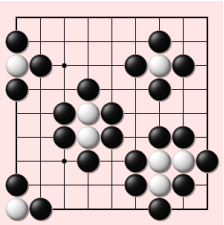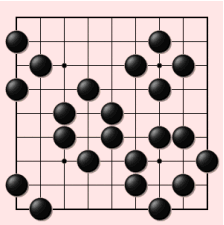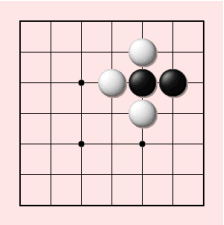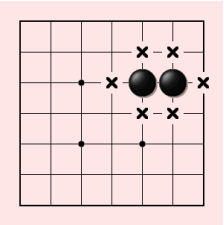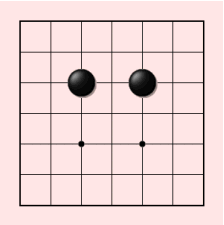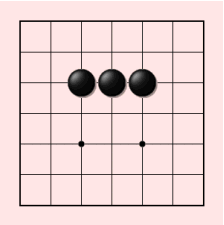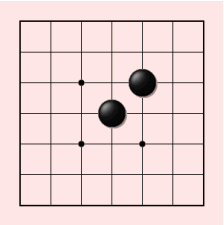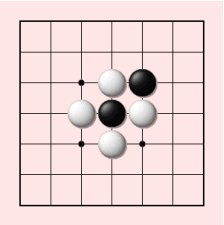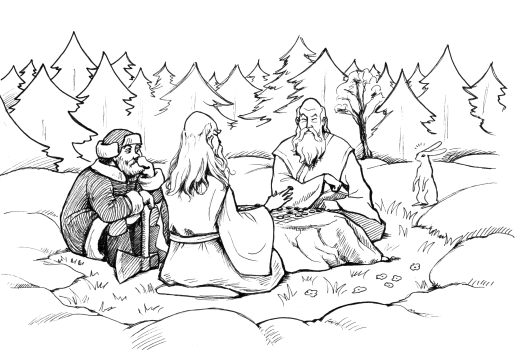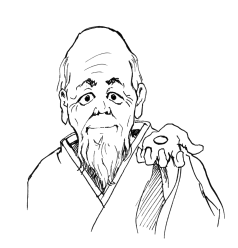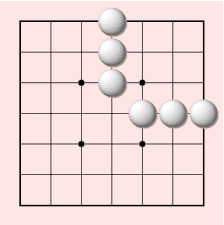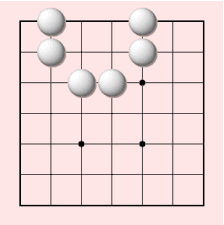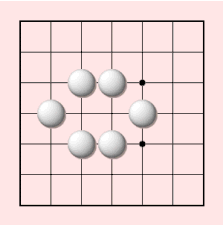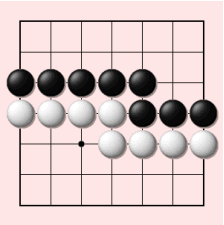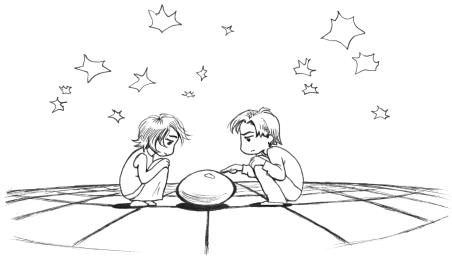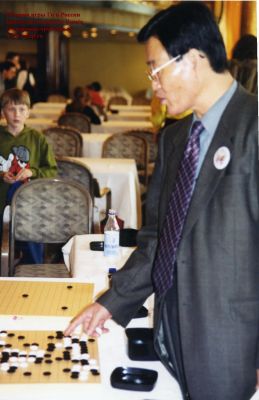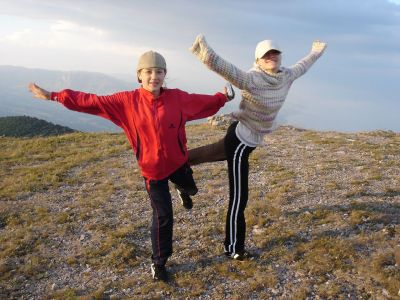..continuation..
Igor Grishin: Timur, in the short rules description there was one that we had held back saying it was not significant for beginners. May be it is high time to tell about it?
Timur Saitov: Certainly, Igor! This rule is called the rule of Ko. Let’s take a look at the stone marked with a triangle.
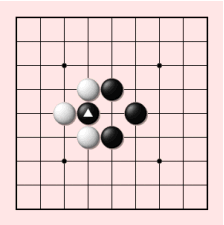
Diagram 33
If white takes it …
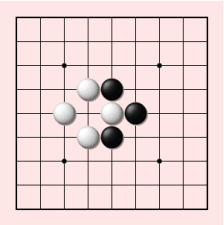
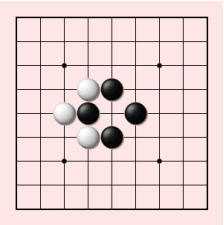
Diagram 34
… the stone will be in the position with only one breathing space. If black captures it there will be the same situation as two moves before. Here black and white can capture stones forever. To avoid this there is a rule of Ko (which means “Eternity” in Japanese): moves that lead to the repetition of the same situation on the board are prohibited.
But can black capture the white stone after all? Yes, he can. But. to do this black should play somewhere else thus creating a new situation on the board. So, this disputed stone can be captured, but only if you have played somewhere else before.
Igor Grishin: Wonderful, Timur! Having learned the rules our readers can easily say that they play with the strength of 30 kyu. Kyu – is the degree of mastery of Go that shows your strength and understanding of Go. The degrees can be student’s ones- kyu, and master’s ones – Dans. With the increase of your mastery your kyu will decrease. The “strongest” kyu is the 1st one. Dans, on the opposite, increase with the increasing of your mastery from 1st to 9th.
But the thing is that kyu and Dans are not just ranks.
What do we have next?
Timur Saitov: Igor, let’s speak on where people can play Go. Go can be played in Go clubs or online:
KGS. Kiseido Go Serverhttp://kgs.kiseido.com
It is rather a big server. There are a lot of players there. To play there you need to download a client software. To make it work you will need to install Java on your PC. If you want to have a rank and want your games to be saved on the server you need to register. The most interesting thing is that it supports Russian language.
IGS. The Internet Go Serverhttp://www.pandanet.co.jp/English
It is one of the biggest Go servers. Thousands of players play there at the same time. The language is English. Most of the players are Japanese, Koreans, and lots of Americans. But there are only a few Russians. The interface is rather convenient.
WINGhttp://www.wing.gr.jp/Indexe.html
Only Japanese people play on this server. There are only few people playing. You can play without any client software, but in order to register you will need to sign in as a guest and only then you will be able to register. It is not very easy to do, but some people may like it.
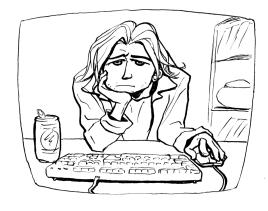
Igor Grishin: But some people still prefer to play live Go, using a wooden board. I admit I’m one of them.
Timur Saitov: Yes, of course, Igor. Live Go and Internet Go can be combined. Moreover, I’ve got some simple questions for our readers I’d like to ask. Here they are:
1. What is more interesting personally for you: to play or to work?
a. No doubt, to play is a lot more interesting!
b. Working is much more interesting for me!
2. How do you prefer to play: alone or together with your friends?
a. I love playing alone!
b. Playing alone is boring – together is much better!
3. Do you get upset when you lose a game of Go?
a. Yes! A lot!
b. Not really, it’s just a game, you know!
4. What do you like best: to finish up a game or it is not so necessary for you?
a. Every game should be finished!
b. It doesn’t matter, if you ask me
You can send your answers to these questions as comments to FAQ.Weiqi.ru or to the game forum
Igor Grishin: You’ve got nice questions, Timur! It makes me want to pick out one of the choices or sometimes even both of them.
Timur Saitov: Your answers, Igor, and questions of the kind can be found on Internet site of Go Master’s Questions and Answers. I do recommend our readers to visit it. The address is Master.weiqi.ru. As far as I know, it was you who started this genre in Russia. And it became very popular among masters and beginners of the game. So everybody can feel where the wind came from. By the way, Igor, would you mind saying a few words about your own method of teaching and self-teaching of Go?
Igor Grishin: Why not if it helps any!
The aim of the game of go is to divide the board space between black and white. The idea of Go is to take your eyes off the board.
The nature of the game of go is competitive. The nature of Go is self-perfection.
Why do we play Go? Because it’s interesting! The game of Go is rich, extraordinary, unique among all other board games, right?
Why do we study Go? To become Masters of Go!
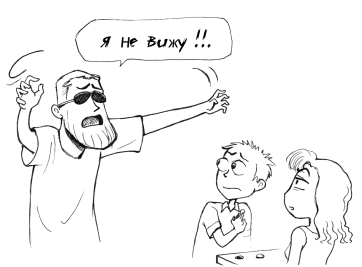
A True Master of Go is a person who left the bounds of the game itself behind. He stepped outside the game…. He stepped outside the result…
Why? Because only there, outside the board, Go begins to realize itself. Go improves and educates all the human evolution centers. It helps us to see new opportunities in our life. Go helps us to build our life, our country. It teaches us, while pointing out the main things, gently and with care treat all the minor and secondary things.
Go teaches us to see and to think.
Seeing means new levels of perception… Levels that we have never reached before.
Thinking means giving life to new ideas… Ideas that come true along the way.
Masters are not necessarily champions, not necessarily the strongest players. Who are they then? Master is the one who left the border lines of victories and losses and helps others to do so.
That’s why Masters of Go are always ready to crush their strength for the true purpose of mastery. If they can’t crush the strength with one single strike, they are able to chop it gradually with constant attempts, trying steadily and irreversibly. It draws themselves together with themselves, together with other people, and consequently together with Go. This is called an Achievement in Go. The one who keeps telling everybody around about his strength, about his rank and so on is extremely far away from the strength and from Go, and from traditions.
But to crush your strength you need to try to gain it first. For this we use the game of Go and, competing in the game, train our abilities and polish techniques acquired at the Go school.
How do I teach Go.
I work as a teacher since 1989. I began as an instructor of martial arts. I trained children and grown-ups. For both of the categories there should be its own approach. Only few of the teaching techniques are universal. I’m always in the process of a constant look-out and try to give the material that gives birth to creativity in all of my students, including myself.
During a year I can teach 3 adult students. No more.
In my Go teaching program I try to reveal the form and the contents of Go on the way to the mastery. Studying according to my program, an industrious student reaches the strength of 1-st Kyu – 1-st Dan in a year. The method is simple, and it doesn’t need learning books by heart or using complicated calculations. We try to achieve the very systematic learning, building not less than 5 elements connected between each other. The systematic approach is the key to the problem of Go. Usually I switch between the pentads according to the individual peculiarities of my student. Afterwards, we try to make all the elements cooperate.
But personally I think that the achievement of one or another rank in Go is not the main point in the practice of Go. One can chase the rank in his childhood, or if he has truly decided to spend a lot of his personal time and resources. In all the other cases the rank itself will not bring any satisfaction at all. To come in Go, spend you time, but not to understand the idea… Why have you been going for that? Isn’t that a strange result?
I try to convince people that the chase of this kind of result isn’t necessary.

Go is a special instrument which is used for cultivating some kind of substance for it to become mastery. To come in Go and not to gain mastery can be compared with the situation when a person, who had come to the shoe shop bought only someone’s shoe-box. Mastery is something more than rating.
There is a saying in the East that one should study only with a good teacher.
A good teacher and his student both always make great efforts to find out why the student needs it. A good teacher is not always the strongest player in the world. The strength always shuts one’s eye and prevents one from seeing. And it happens everywhere. The strength is sharp. The temptation of it is endless. Mastery is like a tableland in the up-hills. It is the tableland where you can live, see friends. You can make hikes up and down. To the side where there is more or less strength. Your expeditions you choose yourself, preparing a great deal for them. You can always come to your tableland – you are not a condemned wanderer who is trying to climb yet another mountain starving to death.
Mastery connects us with people, strength – with the spirit of fights.
It is hard to find yourself in my class. If you have found my name in a commercial you’d better find out whether I teach the course myself or it is one of my students only with my signature under the course.
It is good to study two or three times a week during two hours. But it is right to arrange an experimental course (5 lessons) and then a one-year course if you’d like. You shouldn’t give yourself less time. It can badly influence your nervous system, and besides it will not speed you up. Studying with a teacher you should trust the system your teacher has chosen. That very man has already taken the responsibility for your success. There is no need now to spend your energy on doubts and compares.
All the available resources are to be spent on the system. It is good if you can practice such strategic principles as “not to step out from the school for ten years”, “not to pull the sprouts”. Learning is something more than giving the very energy you need. One should study only on the key field. The key field of your improving. The field itself is always hidden from humans. Learning is an alliance of the student and the teacher the aim of which is the victory in the war. In the war for self-educating.
Timur Saitov:
Thanks, Igor. I think that our readers will appreciate your ideas, and those ideas will help to uncover the non-playing aspects of Go. In conclusion I’ll take the risk quoting the follow up steps of the beginner according to the recipe of the club “Voskhozhdenie”. I personally like those points:
1. Start from the easy looking through the history of Go. Just for self-educating…
2. Find a club, talk about the conditions, have a ride to it and look around to see what happens there – it takes time. But it will pay in the long run.
3. First look more. It is not necessary to think about the Game itself.
4. If the soul would like – find and buy a set.
5. The set should include a board, bowls, and stones. Otherwise it is not a set.
6. Now you can drink good tea and softly put the stones on the board. You are already in art!
7. Think and find the environment where your art will improve.
8. It is good to get some books. Of Masters.
9. Without a system your path is curvy. Try to find one. Who will you be studying with? With a teacher or with friends online?
10. Start a very delicate propaganda among your friends. It is easier to create in a friendly atmosphere…
11. Let yourself go to some far away competition. I would like to sharpen your attention. You are not a tourist. You’re a member of the ancient Brotherhood. Of the Game of Go.
Igor Grishin: Timur, let’s give a list of the Internet sites, that can be useful for beginners and strong players or will help them to find answers to the questions we haven’t looked through here.
Timur Saitov: Ok, here are some sites in Russian:
The game of Go for beginners
Russian Go portal
Go Forum”>
Go in Korea
FAQ on the game of Go
Go teaches us to see
Go Federation News
Classic Go in Diagrams
Go kindergarten
Dances on Goban
Jokes from the Master of Go
The Go Federation
Snail slowly climb up the hill of stones
the game of Go and the Tea club where you can play
Wish you all the best success in mastering the wisdoms of the game of Go. Wish you success in the path of Go.
Special thanks to Sania Mamleeva for wonderful pictures here.
